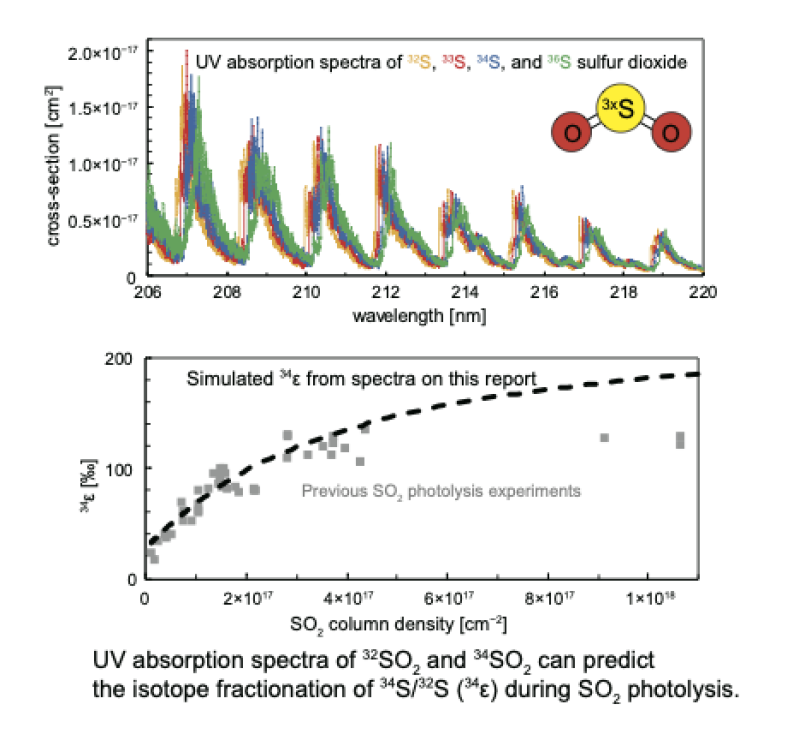
Absorption spectra measurements at ~1 cm–1 spectral resolution of 32S, 33S, 34S, and 36S sulfur dioxide for the 206–220 nm region and applications to modeling of the isotopic self-shielding
ABSTRACT

The sulfur isotope fractionation that occurs during SO2 photolysis is key to explaining the isotope signatures stored in ancient sedimentary rocks and understanding the atmospheric compositions of the early Earth and early Mars. Here, we report the photoabsorption cross-sections of 32SO2, 33SO2, 34SO2, and 36SO2 measured from 206 to 220 nm at 296 K. The wavelength resolution was set to 1 cm–1, 25 times higher than that of previous SO2 isotopologue absorption spectra measurements. The precision of ~10% is in agreement with previously reported SO2 absorption spectra. In comparison with previously reported high-resolution spectra of natural abundance, SO2 measurements demonstrate smaller cross-sectional magnitudes at absorption peaks and an offset wavelength by ~0.016 nm. Using the newly recorded isotopologue spectra, we calculated the sulfur isotope fractionation for self-shielding during SO2 photolysis. The calculated 34S fractionation (34ε) roughly reproduces the observed relationship between 34ε and the SO2 column density in previous photolysis experiments. Thus, the cross-section is useful for predicting 34S/32S isotope fractionation in an optically thick SO2 atmosphere. In contrast, for mass-independent fractionation (MIF-S, i.e., non-zero Δ33S), the measured spectra predicted a weakly negative Δ33S/δ34S slope of about –0.1. The small Δ33S/δ34S slope is consistent with the slopes of SO2 photolysis experiments under high-pressure atmospheres (i.e., the pressure broadened absorption line width will be comparable to the spectral resolution). Therefore, MIF-S during photolysis experiments was linked to spectroscopic measurements for the first time. We conclude that reasonable precision and high-resolution spectroscopic measurements are key to explaining the origin of MIF-S at column densities below 1018 cm–2. However, MIF-S production in chamber experiments or atmospheric conditions may require understanding pressure or temperature effects, such as linewidth broadening on the UV-absorption spectra, and how these effects manifest themselves on isotopologues.
KEYWORDS
Sulfur dioxide, Sulfur isotopes, Mass-independent fractionation, Self-shielding, Early Earth atmosphereSupplementary Materials(file)
https://www.jstage.jst.go.jp/article/geochemj/56/1/56_GJ22004/_supplement/_download/56_GJ22004_1.pdf
- Published : 2022
- Released on J-STAGE : 2022/02/28
- Received : 2021/06/18
- Accepted : 2021/10/20
- DOI : https://doi.org/10.2343/geochemj.GJ22004
- J-STAGE URL : https://www.jstage.jst.go.jp/article/geochemj/56/1/56_GJ22004/_article/-char/ja
- J-Online ISSN: 1880-5973
- Print ISSN : 0016-7002
- ISSN-L : 0016-7002
All Issues
- Vol.59, 2025
- Vol.58, 2024
- Vol.57, 2023
- Vol.56, 2022
- Vol.55, 2021
- Vol.54, 2020
- Vol.53, 2019
- Vol.52, 2018
- Vol.51, 2017
- Vol.50, 2016
- Vol.49, 2015
- Vol.48, 2014
- Vol.47, 2013
- Vol.46, 2012
- Vol.45, 2011
- Vol.44, 2010
- Vol.43, 2009
- Vol.42, 2008
- Vol.41, 2007
- Vol.40, 2006
- Vol.39, 2005
- Vol.38, 2004
- Vol.37, 2003
- Vol.36, 2002
- Vol.35, 2001
- Vol.34, 2000
- Vol.33, 1999
- Vol.32, 1998
- Vol.31, 1997
- Vol.30, 1996
- Vol.29, 1995
- Vol.28, 1994
- Vol.27, 1993
- Vol.26, 1992
- Vol.25, 1991
- Vol.24, 1990
- Vol.23, 1989
- Vol.22, 1988
- Vol.21, 1987
- Vol.20, 1986
- Vol.19, 1985-1986
- Vol.18, 1984
- Vol.17, 1983
- Vol.16, 1982
- Vol.15, 1981
- Vol.14, 1980
- Vol.13, 1979
- Vol.12, 1978
- Vol.11, 1977
- Vol.10, 1976
- Vol.9, 1975
- Vol.8, 1974
- Vol.7, 1973
- Vol.6, 1972-1973
- Vol.5, 1971
- Vol.4, 1970-1971
- Vol.3, 1969-1970
- Vol.2, 1968
- Vol.1, 1966-1967




